A Brief Family History
The Russian heritage can perhaps be traced back in several directions to
RURIK in the north, GENGHIS KHAN and the Golden Horde in the east, and
SELIVAN KOTCHU-BEY in the south. Thus, the family tree most probably has
roots incorporating the three primary influences on RUSSIA - the Vikings,
the Mongols and the Ottomans.
The Mouravieff descendancy
RURIK, regarded as the first of the RUS and the origin of the name given
to RUSSIA, was born about 810 and died about 879. His origin is thought
to be Scandinavian, or possibly Jutland (present day Denmark) from a Viking
clan, an offshoot of the Varangians. There are differing theories as to
whether he and his clan invaded the area of KIEV or whether he was invited
in to provide security as a mercenary force against invaders attempting
to disrupt the lucrative trading activities centered in Novgorod on the
Volkhov river. In any case, his kinsman Oleg founded the grand principality
of Kiev and was succeeded by Prince Rurik's son IGOR (912 - 945) who is
considered to be the real founder of the Russian princely house.
The descendants of IGOR established among other princely houses those of
Moscow and Tver. The MOURAVIEFFs are allegedly descendants of YAROSLAV
(Grand Prince of VLADIMIR 1264-1271) and actual records of them have
been documented as early as 1488. The MOURAVIEFF name is often associated
with high ranking military and diplomatic posts. A MOURAVIEFF led Russian
conquests of Poland under Catherine the Great, the establishment of the
Amur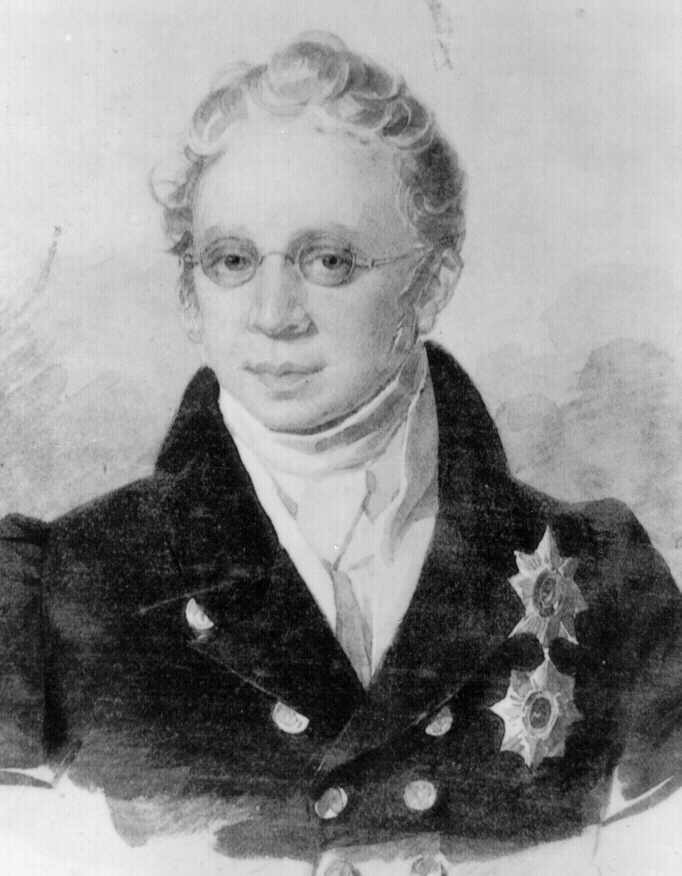 and Ussuri Rivers as the boundary with China in 1858 and the founding of
Vladivostok in 1860. The Amursky Peninsula, a large peninsula
in Siberia where Vladivostok is situated is named to this day after Nicolai
Muraviev who was given the title of Count Amursky. The Mouravieff name
is also closely associated with the Decembrist uprising in 1825 against
Czar Nicholas I. In 1751, Ivan Mouravieff married the only daughter of
Peter Apostol, the son of Hetman Daniel Apostol. In 1755, at the request
of Peter, Ivan's son Matvei agreed to attach the Apostol name to his own
to prevent the Apostol family name from dying out. Thus was born the name
Mouravieff-Apostol.
and Ussuri Rivers as the boundary with China in 1858 and the founding of
Vladivostok in 1860. The Amursky Peninsula, a large peninsula
in Siberia where Vladivostok is situated is named to this day after Nicolai
Muraviev who was given the title of Count Amursky. The Mouravieff name
is also closely associated with the Decembrist uprising in 1825 against
Czar Nicholas I. In 1751, Ivan Mouravieff married the only daughter of
Peter Apostol, the son of Hetman Daniel Apostol. In 1755, at the request
of Peter, Ivan's son Matvei agreed to attach the Apostol name to his own
to prevent the Apostol family name from dying out. Thus was born the name
Mouravieff-Apostol.
The Apostol
descendancy
In 1238, a MONGOL army under Batu, grandson of GENGHIS KHAN, invaded
Rus and in 1240 captured KIEV. It was ransacked many times over the ensuing
100 years by the Tatars based in the Crimea. It is most probable that the
APOSTOL family has its roots in the Crimea and served as the Khan's representative
ruling over regions to the south and east of Kiev. Indeed, the word "Apostol"
in Russian means "designated Chief of the conquered
nation". These feudal states
were headed by a Hetman who was elected by the various tribal chiefs. The first documented APOSTOL is PAUL, born about 1630. His son, the Hetman Daniel
(Danylo),
was born in 1654 and died in 1737. This was the Hetman Period in the Ukraine's
history . His father or grandfather probably helped the Cossacks in 1648
capture KIEV and then under increasing  military
pressure from the Polish offered their allegiance to Moscow under Tsar
Peter the Great. The Treaty of Andrusovo in 1667 concluded the
military
pressure from the Polish offered their allegiance to Moscow under Tsar
Peter the Great. The Treaty of Andrusovo in 1667 concluded the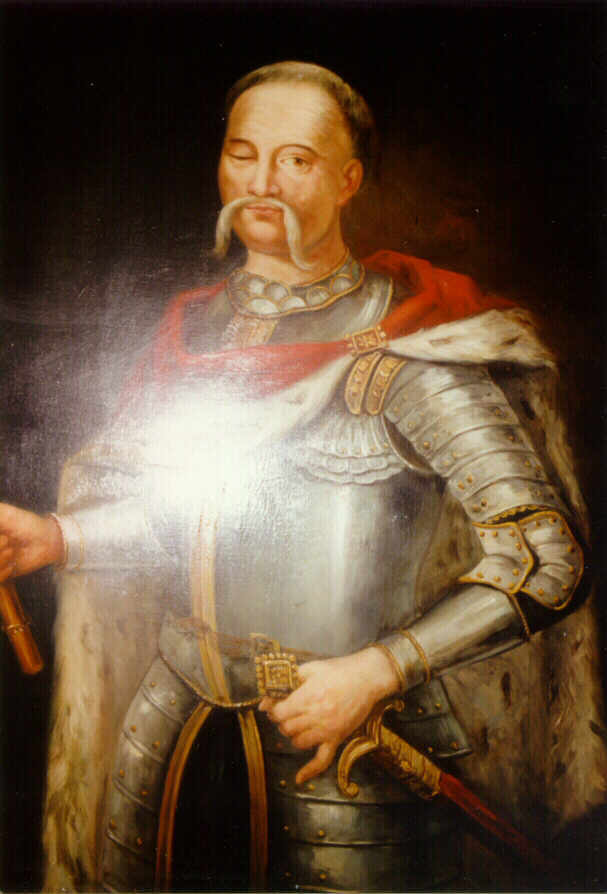 absorption of the Ukraine west of the Dnieper into the Russian Empire as
an autonomous Cossack state under the protection of Moscow. By 1686 Kiev
became part of Russia and under Catherine the Great in 1793, the Ukraine
east of the Dnieper River had also joined the Russian Empire. Daniel Apostol
was the last of the freely elected Hetman (Ataman) warlords and was elected from the city
of Glouchov though his residence was in Khomoutetz near Mirhorod and the
village of Poltava. He built his church at Velikii-Sorochintzi made famous
by the 19th century poet Gogol. His rule ended in 1725. Little is known
of his son Peter except that Peter's daughter, Elena, married Matvei Mouravieff in 1751 and Peter's
grandson, Michael, the last to bear the APOSTOL name, later requested
their son, IVAN, to add the name APOSTOL so that the APOSTOL family name
would live on.
absorption of the Ukraine west of the Dnieper into the Russian Empire as
an autonomous Cossack state under the protection of Moscow. By 1686 Kiev
became part of Russia and under Catherine the Great in 1793, the Ukraine
east of the Dnieper River had also joined the Russian Empire. Daniel Apostol
was the last of the freely elected Hetman (Ataman) warlords and was elected from the city
of Glouchov though his residence was in Khomoutetz near Mirhorod and the
village of Poltava. He built his church at Velikii-Sorochintzi made famous
by the 19th century poet Gogol. His rule ended in 1725. Little is known
of his son Peter except that Peter's daughter, Elena, married Matvei Mouravieff in 1751 and Peter's
grandson, Michael, the last to bear the APOSTOL name, later requested
their son, IVAN, to add the name APOSTOL so that the APOSTOL family name
would live on.

Daniel Apostol's residence at Homoutetz built c. 1730
The Hlopov descendancy
Nothing is known of this family prior to NADEHZDA (affectionately known
as Baboushka) marrying Theodore (FEODOR) TERESTCHENKO in 1883. Their daughter,
NADEHZDA FEODOROVNA, would
then marry Vladimir MOURAVIEFF-APOSTOL-KOROBYINE. However,
family tradition passed down suggests that this wealthy family in KIEV
could trace its lineage back to King Pepin III the Short of France, father
of Charlemagne (721 AD). Since Pepin III expanded his empire considerably
and exchanged ambassadors with the Byzantine Emperor and the Caliphate
of Baghdad, it is reasonable that some of his descendants could have settled
in the easternmost parts of his empire.
The Terestchenko
descendancy
This family first appears in KIEV during the 18th century and the first
recorded ancestor is Artemyi TERESTCHENKO, father of Theodore TERESTCHENKO.
THEODORE and his brother, NIKOLA, contributed huge sums of money
to the development of KIEV and many of its institutions. Nikola's daughter,
Barbara, married Bogdan HANENKO and together they established a collection
of art in the Hanenko Museum of Kiev, financed in large part by the couple's
father and uncle. The collection is now housed in two parts in the restored
mansions of NIKOLA and THEODORE TERESTCHENKO located in KIEV on Boulevard
Terestchenko.
The
Mouravieff-Apostol descendancy
The first MOURAVIEFF-APOSTOL was IVAN, son of MATVEI MOURAVIEFF,
who at the request of PETER APOSTOL'S grandon MICHAEL added the name APOSTOL to that
of MOURAVIEFF in 1800. IVAN's marriage to Anna Tchernoevitch resulted in four daughters
among them, KATERINA, and three sons - MATVEI, SERGEI and HIPOLYTE. The son's became
leaders in the Decembrist movement of 1825 which was crushed by Tsar Nicholas
I resulting in Matvei being banished to Siberia, Sergei being hanged and
Hippolyte losing his life to a gunshot wound that some say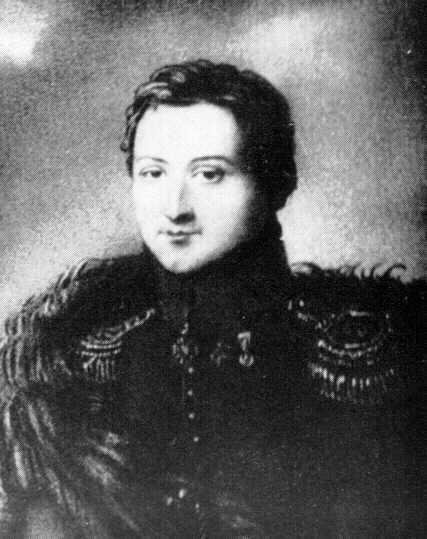 w
w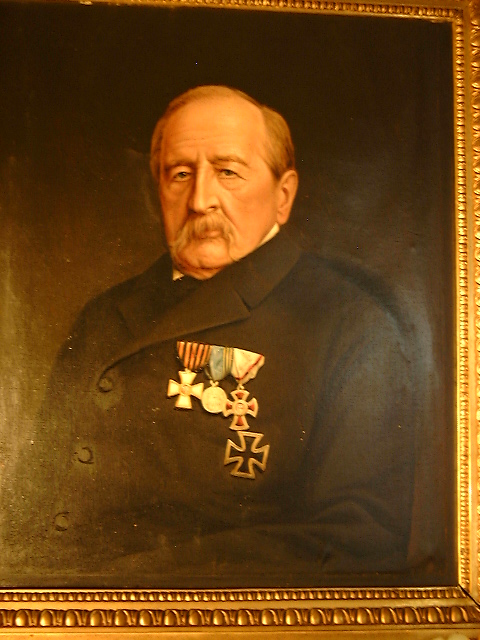 as
self-inflicted. Matvei was eventually allowed to return to his homeland
and had his honor reinstated by Czar Alexander II in 1884. During his last
years, he befriended Vladimir KOROBYINE, his sister KATERINA's grandson.
Katerina married a BIBIKOVand their daughter married Vladimir's father.
Having no children to carry on the name of MOURAVIEFF-APOSTOL, Matvei requested
Vladimir Vladimirovitch KOROBYINE add the name to his. In 1886 by decree of the
Czar,
VLADIMIR KOROBYINE became VLADIMIR MOURAVIEFF-APOSTOL- KOROBYINE. He married Nadehzda Terestchenko and had three sons, Vadim, Andrew and Alexis. Vadim died in 1999 and Alexis died in 2000. Andrew had three sons, Michael,
Christopher and Nicholas. Andrew died in 2002.
as
self-inflicted. Matvei was eventually allowed to return to his homeland
and had his honor reinstated by Czar Alexander II in 1884. During his last
years, he befriended Vladimir KOROBYINE, his sister KATERINA's grandson.
Katerina married a BIBIKOVand their daughter married Vladimir's father.
Having no children to carry on the name of MOURAVIEFF-APOSTOL, Matvei requested
Vladimir Vladimirovitch KOROBYINE add the name to his. In 1886 by decree of the
Czar,
VLADIMIR KOROBYINE became VLADIMIR MOURAVIEFF-APOSTOL- KOROBYINE. He married Nadehzda Terestchenko and had three sons, Vadim, Andrew and Alexis. Vadim died in 1999 and Alexis died in 2000. Andrew had three sons, Michael,
Christopher and Nicholas. Andrew died in 2002.
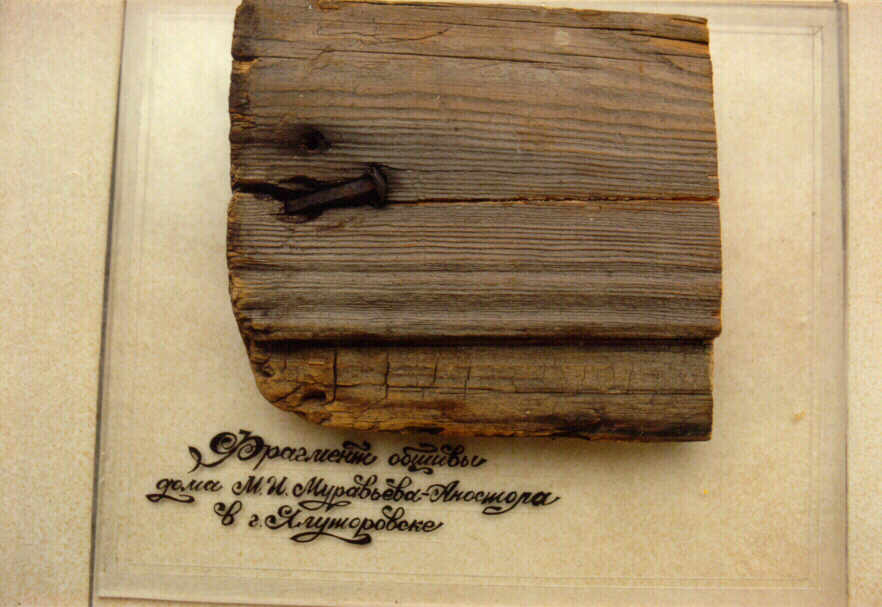
A piece of the log house in Siberia in which Matvei
Mouravieff-Apostol spent some
30 years in exile
The Korobyine descendancy
The KOROBYINE family name has been traced back to a Khan of the Golden Horde
(Kontchak or Kuchak) and his three sons, SELIVAN, KOROBIA and KITCHIS-BEY
in the RIAZAN area who lived from about 1377 to 1463. The Bey
was a title of authority given to rulers of different tribes roaming the
anatolian steppes and other parts of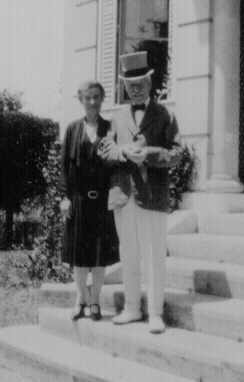 the Ottoman Empire. Apparently, the KOROBIA name became corrupted or
changed such that his son became known as IVAN SELIVANOVITCH KOROBIA .
By about 1482 with the birth of his son, IVAN IVANOVITCH, the name KOROBIA
had become KOROBYINE. Little is known of the family's exploits though the
lineage is well documented. VLADIMIR KOROBYINE (1826-1895) married KATERINA
BIBIKOFF. It was their son, VLADIMIR VLADIMIROVITCH, at the request of
the famed Decembrist, MATVEI MOURAVIEFF-APOSTOL, who in 1886 added the name
MOURAVIEFF-APOSTOL by decree of Czar Alexander II to his own to create
the current family name of MOURAVIEFF-APOSTOL-KOROBYINE.
the Ottoman Empire. Apparently, the KOROBIA name became corrupted or
changed such that his son became known as IVAN SELIVANOVITCH KOROBIA .
By about 1482 with the birth of his son, IVAN IVANOVITCH, the name KOROBIA
had become KOROBYINE. Little is known of the family's exploits though the
lineage is well documented. VLADIMIR KOROBYINE (1826-1895) married KATERINA
BIBIKOFF. It was their son, VLADIMIR VLADIMIROVITCH, at the request of
the famed Decembrist, MATVEI MOURAVIEFF-APOSTOL, who in 1886 added the name
MOURAVIEFF-APOSTOL by decree of Czar Alexander II to his own to create
the current family name of MOURAVIEFF-APOSTOL-KOROBYINE.
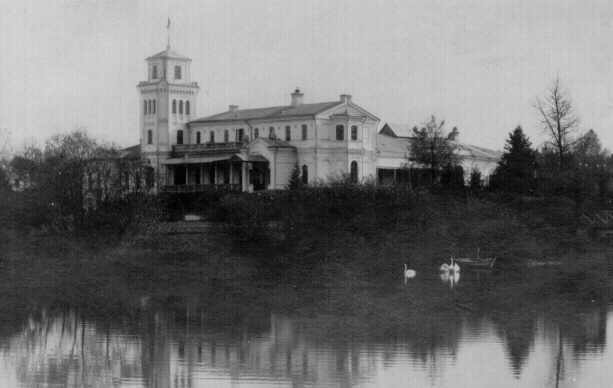
Vladimir Mouravieff-Apostol-Korobyine residence c. 1910
at Leontievka ,Ukraine
 and Ussuri Rivers as the boundary with China in 1858 and the founding of
Vladivostok in 1860. The Amursky Peninsula, a large peninsula
in Siberia where Vladivostok is situated is named to this day after Nicolai
Muraviev who was given the title of Count Amursky. The Mouravieff name
is also closely associated with the Decembrist uprising in 1825 against
Czar Nicholas I. In 1751, Ivan Mouravieff married the only daughter of
Peter Apostol, the son of Hetman Daniel Apostol. In 1755, at the request
of Peter, Ivan's son Matvei agreed to attach the Apostol name to his own
to prevent the Apostol family name from dying out. Thus was born the name
Mouravieff-Apostol.
and Ussuri Rivers as the boundary with China in 1858 and the founding of
Vladivostok in 1860. The Amursky Peninsula, a large peninsula
in Siberia where Vladivostok is situated is named to this day after Nicolai
Muraviev who was given the title of Count Amursky. The Mouravieff name
is also closely associated with the Decembrist uprising in 1825 against
Czar Nicholas I. In 1751, Ivan Mouravieff married the only daughter of
Peter Apostol, the son of Hetman Daniel Apostol. In 1755, at the request
of Peter, Ivan's son Matvei agreed to attach the Apostol name to his own
to prevent the Apostol family name from dying out. Thus was born the name
Mouravieff-Apostol.
 military
pressure from the Polish offered their allegiance to Moscow under Tsar
Peter the Great. The Treaty of Andrusovo in 1667 concluded the
military
pressure from the Polish offered their allegiance to Moscow under Tsar
Peter the Great. The Treaty of Andrusovo in 1667 concluded the

 w
w
 the Ottoman Empire. Apparently, the KOROBIA name became corrupted or
changed such that his son became known as IVAN SELIVANOVITCH KOROBIA .
By about 1482 with the birth of his son, IVAN IVANOVITCH, the name KOROBIA
had become KOROBYINE. Little is known of the family's exploits though the
lineage is well documented. VLADIMIR KOROBYINE (1826-1895) married KATERINA
BIBIKOFF. It was their son, VLADIMIR VLADIMIROVITCH, at the request of
the famed Decembrist, MATVEI MOURAVIEFF-APOSTOL, who in 1886 added the name
MOURAVIEFF-APOSTOL by decree of Czar Alexander II to his own to create
the current family name of MOURAVIEFF-APOSTOL-KOROBYINE.
the Ottoman Empire. Apparently, the KOROBIA name became corrupted or
changed such that his son became known as IVAN SELIVANOVITCH KOROBIA .
By about 1482 with the birth of his son, IVAN IVANOVITCH, the name KOROBIA
had become KOROBYINE. Little is known of the family's exploits though the
lineage is well documented. VLADIMIR KOROBYINE (1826-1895) married KATERINA
BIBIKOFF. It was their son, VLADIMIR VLADIMIROVITCH, at the request of
the famed Decembrist, MATVEI MOURAVIEFF-APOSTOL, who in 1886 added the name
MOURAVIEFF-APOSTOL by decree of Czar Alexander II to his own to create
the current family name of MOURAVIEFF-APOSTOL-KOROBYINE.